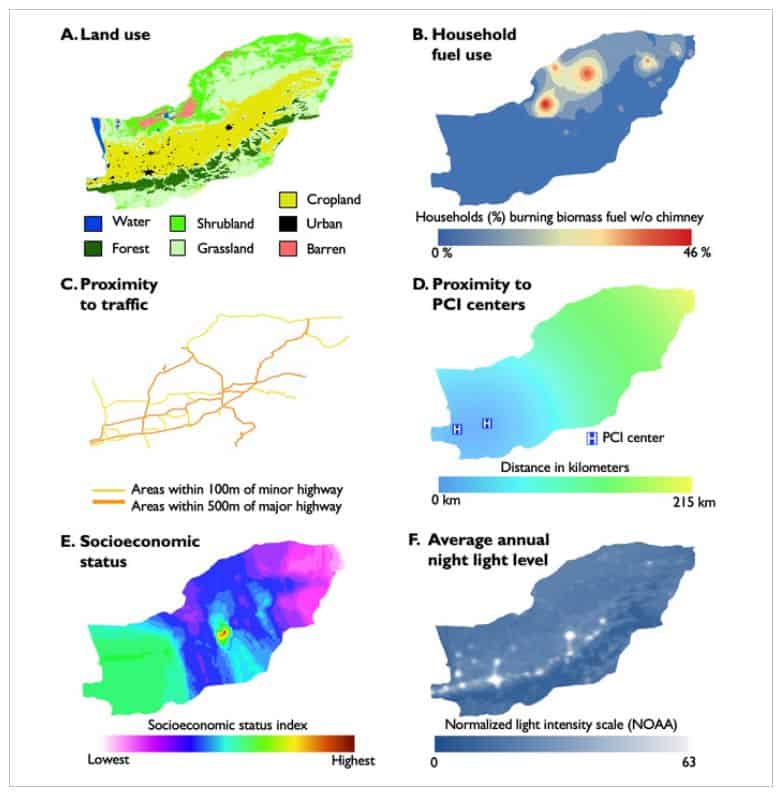A new study reveals that environmental factors like air pollution, together with high blood pressure, diabetes, and smoking, are highly predictive of people’s odds of dying, particularly from heart attack and stroke.
The study, conducted by experts from the Icahn School of Medicine at Mount Sinai and the NYU Grossman School of Medicine, found that exposure to above-average levels of outdoor air pollution increased the risk of mortality by 20% and the risk of death from cardiovascular disease by 17%.
Using wood- or kerosene-burning stoves without sufficient ventilation through a chimney to cook meals or heat the home significantly increases overall mortality risk (by 23% and 9%, respectively) and cardiovascular mortality risk (by 36% and 19%). Death risk was also higher for people who lived far from specialty clinics and near busy roads.
The conclusions, which were published online today in the journal PLOS ONE, are based on personal and environmental health data obtained from 50,045 primarily poor, rural Iranian people residing in the northeastern Golestan province. All participants in the trial were over the age of 40 and volunteered to annual health checks with researchers beginning in 2004.
Researchers claim that their most recent study not only identifies the environmental elements that pose the greatest danger to the heart and overall health but also provides much-needed empirical evidence from individuals in low- and middle-income nations. The researchers point out that traditional research on environmental risk factors has favored urban people in high-income nations because they have much easier access to contemporary health care facilities.
Those living farther away from clinics with catheterization labs capable of unblocking clogged arteries, for example, had a 1% greater risk of death for every 10 kilometers (6.2 miles) of distance. Most inhabitants in Golestan reside more than 50 miles (80 kilometers) away from such modern amenities.
The study also found that one-third of study participants who resided within 500 meters (1,640 feet) of a major highway had a 13% higher chance of death.

According to the study senior author and cardiologist Rajesh Vedanthan, MD, MPH, their “study highlights the role that key environmental factors of indoor/outdoor air pollution, access to modern health services, and proximity to noisy, polluted roadways play in all causes of death and deaths from cardiovascular disease in particular.”
“Our findings help broaden the disease-risk profile beyond age and traditional personal risk factors.”
According to study lead author Michael Hadley, MD, a fellow in cardiology and incoming assistant professor of medicine at Mount Sinai, “this study advances our understanding of which environmental factors may be most detrimental to cardiovascular health.”
“By combining many environmental factors in a single model, we could better control for interactions between risk factors, and identify which environmental risk factors matter most for cardiovascular health.”
By contrast, the research found that other environmental factors included in the analysis — low neighborhood income levels, increased population density, and too much nighttime light exposure — were not independent predictors of risk of death, despite previous research in mostly urban settings suggesting otherwise.
Researchers examined data collected through December 2018 for the investigation. They subsequently developed a predictive model for the risk of overall death and cardiovascular disease death.
In order to improve the forecasting model’s accuracy, the study team intends to carry out further investigation and aims to apply it to other nations. They claim that their new tool might be used as a reference for assessing whether changes to the environment, way of living, and individual health have an impact on death rates around the world.
According to the World Health Organization, environmental factors such as poor air and water quality, a lack of sanitation, and exposure to harmful chemicals now account for 25% of all deaths globally.
Image Credit: Getty
You were reading: Unusual Risk Factors Increasing Risk Of Early Death From Heart Disease: It Is Likely Not What You Think
